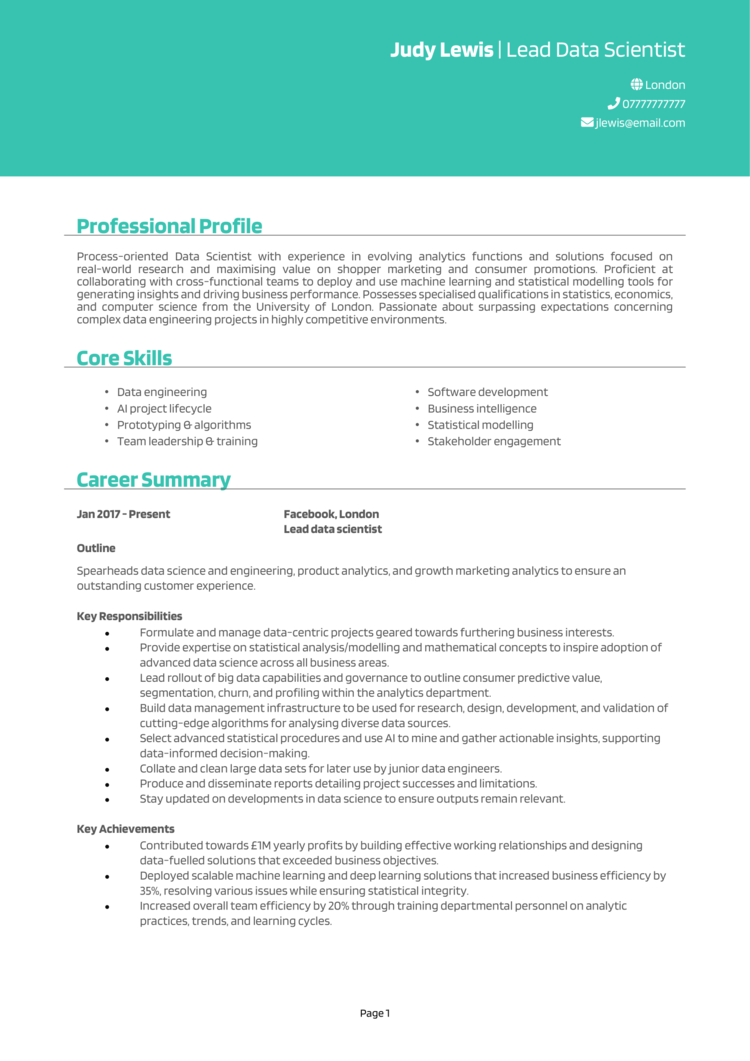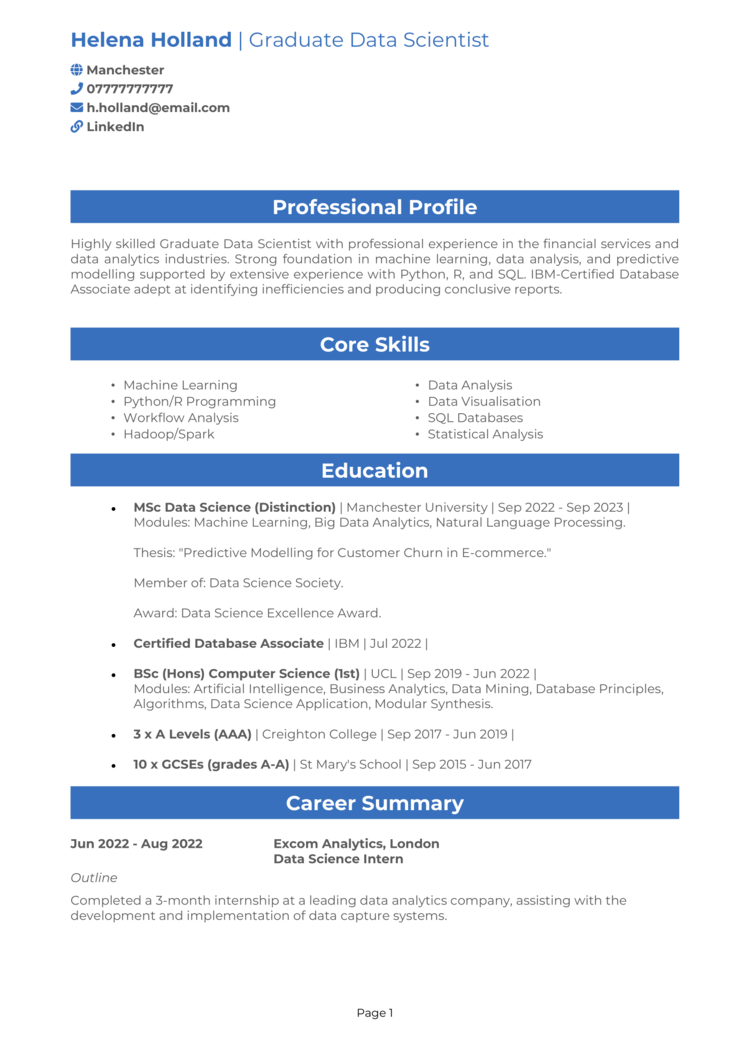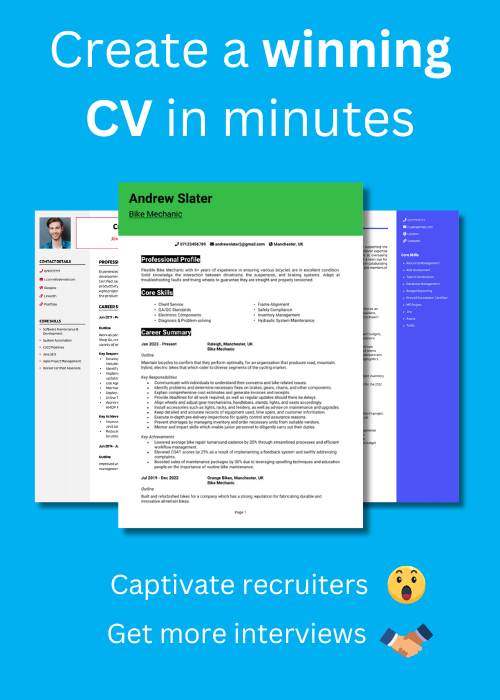As a Data Scientist, you’re not just crunching numbers – you’re transforming them into actionable strategies that shape the future of businesses. But before you can optimise any algorithms, you’ll need to optimise something else first: your CV.
This guide, complete with 6 Data Scientist CV examples, will help you craft a CV that highlights your skills, projects, and technical expertise to land your next big role.
Data Scientist CV

Lead Data Scientist CV

Data Science Graduate CV

Entry Level Data Scientist CV

Graduate Data Scientist CV

Junior Data Scientist CV

How to write your Data Scientist CV
Learn how to create your own interview-winning Data Scientist CV with this simple step-by-step guide.
This guide will walk you step-by-step through writing a Data Scientist CV. From structuring and formatting it to showcasing your analytical expertise, technical skills, and project outcomes, you’ll have everything you need to make a lasting impression on recruiters.
Data Scientist CV structure


A well-organised structure is like a clean dataset – easy to interpret and ready for action. Recruiters need to quickly see your skills, tools, and achievements, so your layout must be clear and concise.
Here’s how to structure your Data Scientist CV:
- Name and contact details – Keep contact details at the top so employers can easily reach you. Inserting a photo isn’t usually required; it’s your choice.
- Profile – Begin with a concise summary that highlights your expertise and what you bring to the role, such as your expertise in data science, technical skills, and career goals.
- Core skills – Focus on the core strengths such as machine learning, statistical analysis, and data visualisation – quickly state them with a few bullet points.
- Work experience – List your roles in reverse chronological order, focusing on measurable contributions.
- Education – Mention foundational academic qualifications and certifications relevant to data science.
- Additional info – Also, there’s the option mention interests, publications, hackathons, or personal projects that showcase your passion.
How to format your Data Scientist CV


Your CV should reflect the clarity and precision you bring to data analysis. Even the most impressive achievements won’t shine in a poorly formatted CV. Don’t let these mistakes hold you back!
Here’s how to format your Data Scientist CV:
- Bullet points – Use these to make responsibilities and contributions easy for a busy recruiter to skim through.
- Divide sections – Clear headings ensure the recruiter can quickly navigate your CV.
- Use a clean font – Prioritise readability with a professional font and subtle layout.
- No more than 2 pages – Keep it the right length while providing enough detail to showcase your expertise.
Data Scientist CV profile


Your CV profile is your first impression, giving recruiters a snapshot of your skills and accomplishments in data science. It’s where you highlight your ability to uncover insights, drive decisions, and implement data-driven strategies.
Data Scientist CV profile examples
Profile 1
Analytical Data Scientist with five years of experience in e-commerce, specialising in predictive modelling, machine learning, and data visualisation. Skilled in Python, SQL, and Tableau to extract insights and drive strategic decisions.
Profile 2
Dedicated Data Scientist with three years of experience in healthcare analytics, focusing on patient outcome prediction and resource optimisation. Proficient in R, TensorFlow, and cloud platforms like AWS to build scalable solutions.
Profile 3
Proficient Data Scientist with over eight years of experience in financial services, adept at developing algorithms for fraud detection and portfolio optimisation. Skilled in Spark, SAS, and Power BI to handle large datasets and provide actionable insights.
What to include in your Data Scientist CV profile
Here are some tips on what to include in your Data Scientist profile:
- Where you’ve worked – Mention industries or companies, such as finance, healthcare, or tech startups.
- Your top qualifications – Highlight degrees like a Master’s in Data Science or relevant certifications.
- Essential skills – Include strengths like machine learning, statistical modelling, and data visualisation.
- Types of data you’ve worked with – Specify customer data, financial figures, or other specialised datasets.
- Relevant tools you know – List proficiency with tools like Python, SQL, TensorFlow, or Tableau.
How to highlight your core skills


Your core skills section is your CV’s toolkit, allowing recruiters a speedy glance at the technical and analytical skills you bring to the role.
For Data Scientists, this might include programming, machine learning, and data wrangling. Tailor these skills to the job description, focusing on those most relevant to the role.
The top skills to highlight in your Data Scientist CV
- Machine Learning – Designing and deploying predictive models using supervised and unsupervised techniques.
- Programming Languages – Proficient in Python, R, and SQL for data analysis and model development.
- Big Data Tools – Experience with Hadoop, Spark, and AWS for managing large datasets.
- Statistical Modelling – Applying regression, clustering, and hypothesis testing to solve business problems.
- Data Wrangling – Cleaning and transforming raw data into usable formats for analysis.
- Data Visualisation – Creating dashboards with Tableau, Power BI, and Matplotlib to communicate insights.
- A/B Testing – Designing experiments to optimise products and strategies.
- Cloud Platforms – Deploying scalable models on AWS, Google Cloud, or Azure.
- Deep Learning – Developing neural networks with TensorFlow and PyTorch.
- Predictive Analytics – Leveraging algorithms to forecast trends and behaviours.
Work experience


Your work experience section is where you demonstrate your impact as a Data Scientist. Recruiters want to see how your analysis has driven results, improved processes, or uncovered valuable insights.
List your roles in reverse chronological order, focusing on responsibilities and achievements. If you’re new to the field, include academic projects, internships, or freelance work that showcases your skills.
How to structure jobs

- Outline – Provide an overview of the organisation, your role, and the types of data or projects you worked on.
- Responsibilities – Highlight tasks like building predictive models, conducting analyses, or presenting findings. Use action verbs like “developed,” “analysed,” or “implemented.”
- Achievements – Showcase measurable outcomes, such as improved efficiency or increased revenue. Numbers and figures make a stronger impact, so include them wherever possible.
Example jobs for Data Scientist
Data Scientist | Insight Inc
Outline
Designed and implemented predictive models for an e-commerce analytics company, focusing on customer behaviour insights to drive sales growth. Developed scalable machine learning solutions to enhance data-driven decision-making.
Responsibilities
- Built and optimised machine learning models using Python and TensorFlow.
- Processed and cleaned large datasets from various sources for accurate analysis.
- Developed visualisation dashboards using Tableau to communicate findings to stakeholders.
- Collaborated with marketing teams to optimise customer targeting strategies.
- Evaluated model performance and implemented improvements to enhance accuracy.
Achievements
- Increased customer retention by 20% through advanced churn prediction models.
- Reduced data processing time by 30% by streamlining ETL pipelines.
- Received internal award for developing a recommendation system that boosted sales by 15%.
Data Scientist | Healthstats
Outline
Conducted data analysis and built predictive models for a healthcare analytics firm, improving patient care outcomes and operational efficiency. Focused on leveraging machine learning to optimise hospital resource allocation.
Responsibilities
- Analysed patient data to identify trends and build predictive models for outcome prediction.
- Developed machine learning pipelines using R and cloud-based tools like AWS SageMaker.
- Presented data-driven insights to healthcare providers to inform strategic decisions.
- Worked with cross-functional teams to ensure data quality and integrity.
- Monitored and maintained compliance with healthcare data security regulations.
Achievements
- Improved patient discharge predictions by 25% using a customised ML algorithm.
- Optimised resource allocation, reducing wait times by 15% in a major hospital network.
- Secured £200,000 in additional funding for analytics projects through evidence-based proposals.
Data Scientist | FinIQ
Outline
Worked as a Data Scientist for a financial services company, focusing on fraud detection and risk modelling. Developed data-driven strategies to mitigate risks and improve portfolio performance.
Responsibilities
- Designed fraud detection algorithms using Spark and SAS for large-scale financial data.
- Built and tested predictive models to assess credit risk and portfolio health.
- Collaborated with compliance teams to ensure adherence to financial regulations.
- Created interactive dashboards in Power BI to provide actionable insights to stakeholders.
- Monitored market trends to develop investment strategies based on data analytics.
Achievements
- Reduced fraudulent transactions by 40% using a machine learning-based detection system.
- Increased portfolio returns by 10% by developing a predictive asset allocation model.
- Received a commendation for designing a risk assessment tool adopted company-wide.
What’s the best way to write an education section


The education section is vital for Data Scientists, as it highlights your academic foundation and technical training. Include degrees in data science, computer science, or mathematics, along with relevant certifications.
This section is typically brief but impactful. List your qualifications in reverse chronological order, starting with the most recent.
Key qualifications for a Data Scientist
- Master’s Degree in Data Science – Advanced training in statistical analysis, programming, and machine learning.
- Google Data Analytics Certificate – Covers data cleaning, analysis, and visualisation techniques.
- AWS Certified Machine Learning – Specialty – Certification for building and deploying machine learning models on AWS.
- Tableau Desktop Specialist Certification – Demonstrates expertise in data visualisation and dashboard creation.
- Hadoop and Spark Developer Certification – Validates skills in big data processing and analysis.





